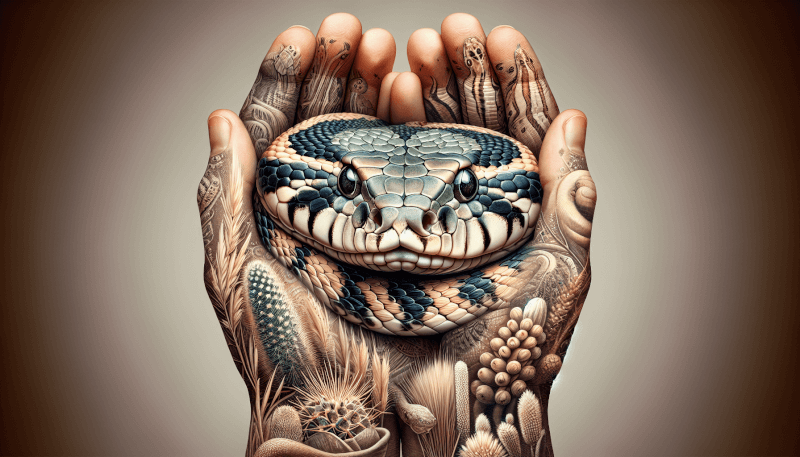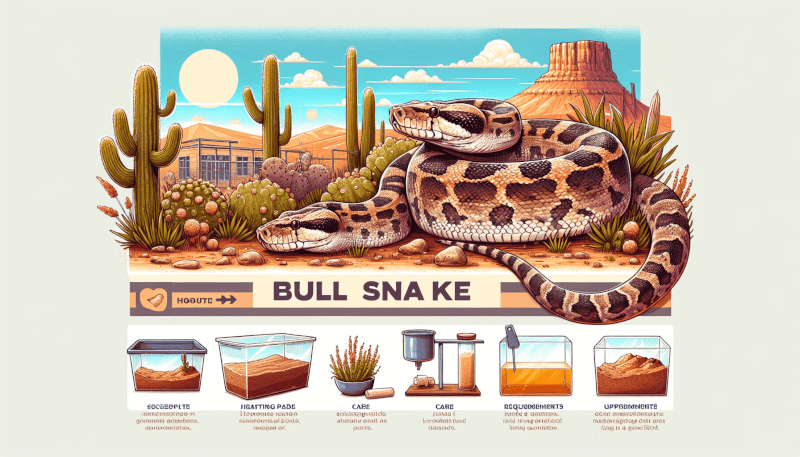So you’ve decided to bring a bull snake into your family and want to make sure you provide the best care possible. Look no further! This comprehensive bull snake care sheet will guide you through all the important aspects of keeping a bull snake as a pet. From setting up their habitat to ensuring they have a healthy diet, we’ve got you covered. Whether you’re a first-time snake owner or have experience with other reptiles, this care sheet will provide you with everything you need to know to keep your bull snake happy and thriving.

Housing
Enclosure size
When it comes to housing your bull snake, it’s important to provide them with an appropriately sized enclosure. The size of the enclosure should allow your snake to move around comfortably and have enough space to stretch out fully. As a general rule of thumb, a snake enclosure should be at least as long as the snake’s body and about one-third to one-half of its body length in width.
Substrate
Choosing the right substrate for your bull snake’s enclosure is crucial for their health and well-being. Some suitable substrate options for bull snakes include aspen shavings, cypress mulch, or newspaper. It’s important to avoid using substrates that can be ingested and cause impaction, such as sand or gravel.
Temperature
Maintaining the correct temperature gradient in your bull snake’s enclosure is essential for their overall health and digestion. Provide a temperature gradient by using heat lamps or under-tank heating pads. The warm side of the enclosure should be around 85-90°F (29-32°C), while the cooler side can be around 75-80°F (24-27°C). It’s important to monitor the temperature regularly to ensure it remains within the appropriate range.
Humidity
Bull snakes do not require high levels of humidity, but it’s still important to provide a humid hide or a small water dish to allow for proper shedding. The humidity level should be kept around 40-50%. Regularly misting the enclosure or providing a humidifier can help maintain the desired humidity level.
Lighting
While bull snakes are primarily nocturnal, it’s still important to provide them with a day and night cycle. You can achieve this by using natural or artificial lighting. A light source that mimics natural daylight is beneficial for both your snake’s physiological and behavioral needs. A light cycle of 12-14 hours of light and 10-12 hours of darkness is recommended.
Feeding
Diet
Bull snakes are carnivores and their diet primarily consists of rodents. It’s important to feed your snake appropriately sized prey items, such as mice or rats. Varying the prey size and type can be beneficial for their overall health and enrichment. It’s crucial to provide your bull snake with properly thawed and warm prey items to prevent any potential health issues.
Frequency
The frequency of feeding your bull snake will depend on its age and size. Generally, young snakes should be fed every 4-7 days, while adult snakes can be fed every 10-14 days. Monitor your snake’s body condition and adjust their feeding schedule accordingly to prevent overfeeding or underfeeding.
Prey size
Selecting the right prey size for your bull snake is important to ensure their health and proper digestion. The prey size should be about the same width as the snake’s body or slightly larger. Avoid offering prey items that are too large, as they can cause regurgitation or other digestive issues.
Feeding techniques
There are several feeding techniques you can use to safely and effectively feed your bull snake. The most common method is using tongs or forceps to offer the prey item to your snake. This helps prevent accidental bites and allows you to maintain a safe distance. Always ensure the prey item is defrosted and warmed to room temperature before offering it to your snake.
Handling and Behavior
Handling techniques
When handling your bull snake, it’s important to approach them calmly and confidently. Support their body along its length, avoiding excessive pressure on their delicate organs. Avoid sudden movements or gripping them too tightly, as this can stress the snake. Start by handling your snake for short periods and gradually increase the duration as they become more comfortable with your presence.
Behavioral traits
Bull snakes are known for being relatively docile and curious snakes. They can be active and explore their surroundings, but they are generally not aggressive. They may hiss or bluff strike when they feel threatened, but this is usually just a defensive mechanism. With proper handling and patience, you can help your bull snake become more accustomed to human interaction.
Taming
Taming a bull snake involves building trust and gradually acclimating them to human presence. Spend time near the enclosure, talking to your snake and allowing them to get used to your scent. Start by gently touching and stroking them while they are in their enclosure before attempting to handle them. Regular, positive interactions will help your bull snake feel more comfortable and tame over time.
Health and Veterinary Care
Regular check-ups
Regular veterinary check-ups are essential to ensure the overall health of your bull snake. A reptile veterinarian can perform a thorough examination, check for any signs of illness, and provide appropriate vaccinations or treatments if necessary. Establishing a good relationship with a reptile veterinarian will help ensure your snake receives proper care throughout its life.
Signs of illness
It’s important to monitor your bull snake closely for any signs of illness or health issues. Some common signs of illness include a loss of appetite, weight loss, changes in behavior, difficulty breathing, abnormal feces, or visible signs of injury or parasites. If you notice any of these signs, it’s crucial to consult a reptile veterinarian as soon as possible.
Common health issues
Bull snakes can be susceptible to various health issues, including respiratory infections, mites, ticks, or skin problems. Maintaining appropriate temperature and humidity levels, providing a clean and well-maintained enclosure, and regular health check-ups can help prevent or address these common health issues.
Vet selection and visits
When selecting a veterinarian for your bull snake, it’s important to choose one with experience and knowledge in reptile care. Look for a veterinarian who specializes in exotic animals or reptiles to ensure your snake receives the best possible care. During veterinary visits, be prepared to provide information about your snake’s diet, habitat, and any observed changes in behavior or health.

Shedding
Frequency
Bull snakes shed their skin periodically as they grow. Young snakes may shed every 4-6 weeks, while adult snakes may shed every 2-3 months. The shedding frequency can vary depending on various factors such as age, growth rate, and environmental conditions.
Signs of shedding
Before shedding, you may notice signs such as a dull or cloudy appearance of the snake’s eyes, decreased activity, and loss of appetite. These are natural indicators that your bull snake is preparing to shed its skin. Providing proper humidity levels and a humid hide will help facilitate the shedding process.
Assisting shedding process
To assist your bull snake during the shedding process, you can provide a humid hide. A humid hide can be created by placing damp moss or paper towels in a hide box. This helps increase the humidity level and allows your snake to easily remove its old skin. Avoid forcefully pulling or peeling the shed skin, as this can cause damage to the new skin beneath.
Habitat Enrichment
Hide boxes
Provide your bull snake with multiple hide boxes throughout the enclosure. These hide boxes should be appropriately sized and positioned in both the warm and cool areas of the enclosure. Bull snakes are secretive creatures by nature, and having hides to retreat to helps reduce stress and promotes natural behaviors.
Climbing branches
Adding climbing branches or perches in the enclosure can provide enrichment for your bull snake. They may enjoy climbing and exploring their surroundings, mimicking their natural behaviors in the wild. Ensure that the branches are secure and stable to prevent any injuries or accidents.
Water dish
A water dish should be provided at all times to ensure your bull snake has access to fresh and clean water. The dish should be large enough for your snake to soak in if desired. Regularly clean and refill the water dish to maintain good hygiene.
Substrate enrichment
Bull snakes can benefit from substrate enrichment. Consider adding natural materials such as leaf litter, twigs, or moss to their substrate. This can provide additional sensory stimulation and mimic their natural habitat.
Toys and environmental stimuli
Introducing safe and appropriate toys or environmental stimuli can help keep your bull snake mentally stimulated. You can provide objects for them to explore, such as PVC pipes or snake-safe branches. It’s important to ensure that all toys are securely placed and cannot cause harm to your snake.
Socialization and Enclosure Mates
Solitary species
Bull snakes are solitary reptiles and generally prefer to live alone. They do not have the same social needs as some other animals, and introducing another snake to their enclosure can potentially lead to stress, aggression, or competition over resources. It’s best to provide your bull snake with a spacious and enriched enclosure where they can thrive on their own.
Enclosure Mates
As a solitary species, bull snakes do not require or benefit from having enclosure mates. It’s important to avoid housing multiple bull snakes together, as this can lead to territorial disputes or potential injuries. It’s always safest and most suitable to provide your bull snake with its own separate enclosure.
Reproduction and Breeding
Mating behavior
Breeding bull snakes should only be attempted by experienced reptile breeders. Mating behavior in bull snakes involves a specific set of environmental and seasonal cues. Multiple males may compete for the attention of a receptive female. It’s important to have a well-researched breeding plan and be prepared to provide appropriate care for the resulting offspring.
Egg incubation
After successful mating, female bull snakes will lay a clutch of eggs that need to be incubated in a separate container. The eggs should be carefully placed in an incubation medium, such as vermiculite or perlite, at the appropriate temperature and humidity. Regular monitoring of the eggs is necessary, and they should hatch after approximately 60-70 days.
Caring for hatchlings
Hatchling bull snakes require specific care and attention. They should be housed individually in smaller enclosures to ensure proper feeding and growth. The enclosure should have appropriate temperature and humidity levels, and the hatchlings should be offered appropriately sized prey items. Regular observation and consultation with an experienced reptile breeder or veterinarian is recommended during this crucial stage.
Legal Considerations
Applicable laws and permits
Before acquiring a bull snake, it’s important to familiarize yourself with the applicable laws and regulations regarding the ownership and keeping of this species. Some jurisdictions may require permits or licenses to keep certain species of snakes. Ensure that you obtain any necessary permits and comply with local laws to ensure responsible ownership.
Responsible ownership
Responsible ownership of a bull snake requires providing appropriate care, nutrition, and a suitable environment for their well-being. It’s important to prioritize the ethical and legal considerations associated with owning a pet snake. Educate yourself about their natural behaviors, needs, and any specific requirements they may have to ensure you can provide them with a quality life in captivity.
Conclusion
In conclusion, caring for a bull snake requires attention to detail, a commitment to research, and providing an environment that meets their specific needs. By ensuring proper housing, feeding, handling, veterinary care, and enrichment, you can provide your bull snake with a happy and healthy life in captivity. Remember, responsible ownership and ongoing education are key to providing the best care for your reptilian companion.


